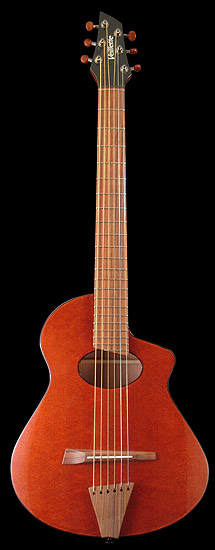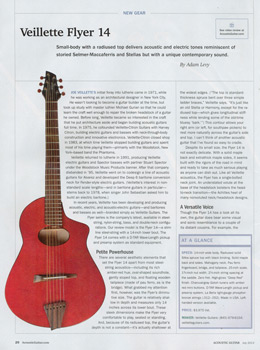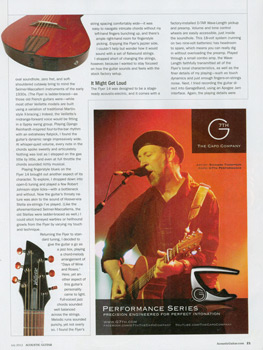
|
Articles
Joe Veillette’s initial foray into lutherie came in 1971, while he was working as an architectural designer in New York City. He wasn’t looking to become a guitar builder at the time, but took up study with master luthier Michael Gurian so that he could learn the craft well enough to repair the broken headstock of a guitar he owned. Before long, Veillette became so interested in the craft that he put architecture aside and began building acoustic guitars full time. In 1975, he cofounded Veillette-Citron Guitars with Harvey Citron, building electric guitars and basses with neck-through-body construction and innovative electronics. Veillette-Citron closed shop in 1983, at which time Veillette stopped building guitars and spent most of his time playing them—primarily with the Woodstock, New York–based band the Phantoms. Veillette returned to lutherie in 1991, producing Veillette electric guitars and Spector basses with partner Stuart Spector under the Woodstock Music Products banner. After that company disbanded in ’95, Veillette went on to codesign a line of acoustic guitars for Alvarez and developed the Deep 6 baritone conversion neck for Fender-style electric guitars. (Veillette’s interest in nonstandard scale lengths—and in baritone guitars in particular—stems back to 1978, when singer John Sebastian asked him to build an electric baritone.) In recent years, Veillette has been developing and producing acoustic, electric, and acoustic-electric guitars—and baritones and basses as well—branded simply as Veillette Guitars. The Flyer series is the company’s latest line, available in steel-string, nylon-string, bass, and double-neck configurations. Our review model is the Flyer 14—a slimline steel-string with a 14-inch lower bout. The Flyer 14 comes with a D-TAR Wave-Length pickup and preamp system as standard equipment. Petite Powerhouse Despite its small size, the Flyer 14 is not exactly delicate. With a solid maple back and extrathick maple sides, it seems built with the rigors of the road in mind and ready to take as much serious playing as anyone can dish out. Like all Veillette acoustics, the Flyer has a single-bolted neck joint. An understated volute at the base of the headstock bolsters the head-to-neck transition—the Achilles heel of many nonvoluted neck/headstock designs. A Versatile Voice Playing fingerstyle blues on the Flyer 14 brought out another aspect of its character. To explore, I dropped down into open-G tuning and played a few Robert Johnson–style licks—with a bottleneck and without. Now the guitar’s throaty nature was akin to the sound of Hoover-era Stella six-strings I’ve played. (Like the aforementioned Selmer-Maccaferris, the old Stellas were ladder-braced as well.) I could elicit honeyed warbles or hellhound growls from the Flyer by varying my touch and technique. Returning the Flyer to standard tuning, I decided to give the guitar a go as a jazz box, playing a chord-melody arrangement of “Days of Wine and Roses.” Here, yet another aspect of this guitar’s personality came to light. Full-voiced jazz chords sounded well balanced across the strings. Melodic runs sounded punchy, yet not overly so. I found the Flyer’s string spacing comfortably wide—it was easy to navigate intricate chords without my left-hand fingers bunching up, and there’s ample right-hand room for fingerstyle picking. Enjoying the Flyer’s jazzier side, I couldn’t help but wonder how it would sound with a set of flatwound strings. I stopped short of changing the strings, however, because I wanted to stay focused on how the guitar sounds and feels with the stock factory setup.
At a Glance
SPECS: 14-inch wide body. Radiused solid Sitka spruce top with black binding. Solid maple back and sides. Mahogany neck. Pau ferro fingerboard, bridge, and tailpiece. 25-inch scale. 1 3/4-inch nut width. 2 1/4-inch string spacing at the saddle. Zero fret. High-gloss "Deep Red" finish. Charcoal-gray Gotoh tuners with amber-red mini buttons. D-TAR Wave-Length pickup and preamp system. La Bella light-gauge phosphor-bronze strings (.012..052). Made in USA. Left-handed version available. PRICE: $3,975 list. It Might Get Loud A Winning Personality EDITORS’ IMPRESSIONS: TEJA GERKEN: Specialty guitars such as multistrings or baritones not withstanding, the Veillette Flyer 14 is among the most unusual instruments to ever pass through the Acoustic Guitar office. And I mean that in the most positive way—the guitar is incredibly fun to play and offers a unique voice with real-world applications. With a sound that combines equal parts flattop, archtop, and Selmer-Maccaferri-style guitars, the Flyer is bold and assertive, with a spectacularly complex mid-range, and its lightning-fast response and excellent balance would make it a great studio tool. SCOTT NYGAARD: Acoustic archtop sounds have become more and more common in the acoustic music scene these days, as heard in the guitar playing of David Rawlings and Jon Neufeld. This delightful little guitar would make a great instrument for acoustic soloists who want to follow their lead. With a feel more like an acoustic flattop than an archtop, especially the distance between the strings and the top at the soundhole, the Veillette Flyer 14 has a punchy midrange that’s perfect for jazzy leads as well as acoustic blues fingerpicking and flatpicking styles. And the D-TAR electronics do a great job of pumping up the volume while retaining the Flyer’s unique character.
|
| © Veillette Guitars SEARCH OUR SITE |
 Veillette Flyer 14
Veillette Flyer 14

